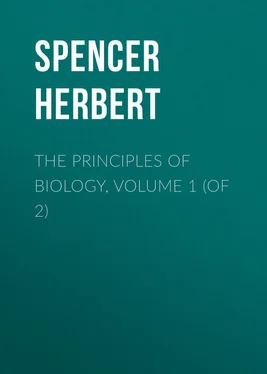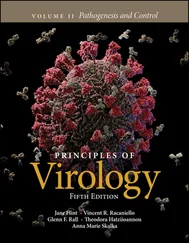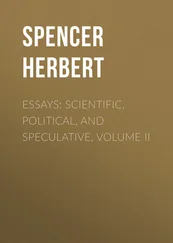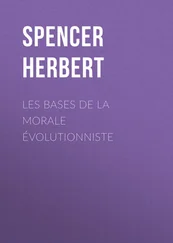Herbert Spencer - The Principles of Biology, Volume 1 (of 2)
Здесь есть возможность читать онлайн «Herbert Spencer - The Principles of Biology, Volume 1 (of 2)» — ознакомительный отрывок электронной книги совершенно бесплатно, а после прочтения отрывка купить полную версию. В некоторых случаях можно слушать аудио, скачать через торрент в формате fb2 и присутствует краткое содержание. Жанр: Философия, foreign_antique, foreign_prose, на английском языке. Описание произведения, (предисловие) а так же отзывы посетителей доступны на портале библиотеки ЛибКат.
- Название:The Principles of Biology, Volume 1 (of 2)
- Автор:
- Жанр:
- Год:неизвестен
- ISBN:нет данных
- Рейтинг книги:3 / 5. Голосов: 1
-
Избранное:Добавить в избранное
- Отзывы:
-
Ваша оценка:
- 60
- 1
- 2
- 3
- 4
- 5
The Principles of Biology, Volume 1 (of 2): краткое содержание, описание и аннотация
Предлагаем к чтению аннотацию, описание, краткое содержание или предисловие (зависит от того, что написал сам автор книги «The Principles of Biology, Volume 1 (of 2)»). Если вы не нашли необходимую информацию о книге — напишите в комментариях, мы постараемся отыскать её.
The Principles of Biology, Volume 1 (of 2) — читать онлайн ознакомительный отрывок
Ниже представлен текст книги, разбитый по страницам. Система сохранения места последней прочитанной страницы, позволяет с удобством читать онлайн бесплатно книгу «The Principles of Biology, Volume 1 (of 2)», без необходимости каждый раз заново искать на чём Вы остановились. Поставьте закладку, и сможете в любой момент перейти на страницу, на которой закончили чтение.
Интервал:
Закладка:
§§ 35, 36. Before closing the chapter, it will be useful to compare the definition of Life here set forth, with the definition of Evolution set forth in First Principles . Living bodies being bodies which display in the highest degree the structural changes constituting Evolution; and Life being made up of the functional changes accompanying these structural changes; we ought to find a certain harmony between the definitions of Evolution and of Life. Such a harmony is not wanting.
The first distinction we noted between the kind of change shown in Life, and other kinds of change, was its serial character. We saw that vital change is substantially unlike non-vital change, in being made up of successive changes. Now since organic bodies display so much more than inorganic bodies those continuous differentiations and integrations which constitute Evolution; and since the re-distributions of matter thus carried so far in a comparatively short period, imply concomitant re-distributions of motion; it is clear that in a given time, organic bodies must undergo changes so comparatively numerous as to render the successiveness of their changes a marked characteristic. And it will follow a priori , as we found it to do a posteriori , that the organisms exhibiting Evolution in the highest degree, exhibit the longest or the most rapid successions of changes, or both. Again, it was shown that vital change is distinguished from non-vital change by being made up of many simultaneous changes; and also that creatures possessing high vitality are marked off from those possessing low vitality, by the far greater number of their simultaneous changes. Here, too, there is entire congruity. In First Principles , § 156, we reached the conclusion that a force falling on any aggregate is divided into several forces; that when the aggregate consists of parts that are unlike, each part becomes a centre of unlike differentiations of the incident force; and that thus the multiplicity of such differentiations must increase with the multiplicity of the unlike parts. Consequently organic aggregates, which as a class are distinguished from inorganic aggregates by the greater number of their unlike parts, must be also distinguished from them by the greater number of simultaneous changes they display; and, further, that the higher organic aggregates, having more numerous unlike parts than the lower, must undergo more numerous simultaneous changes. We next found that the changes occurring in living bodies are contrasted with those occurring in other bodies, as being much more heterogeneous ; and that the changes occurring in the superior living bodies are similarly contrasted with those occurring in inferior ones. Well, heterogeneity of function is the correlate of heterogeneity of structure; and heterogeneity of structure is the leading distinction between organic and inorganic aggregates, as well as between the more highly organized and the more lowly organized. By reaction, an incident force must be rendered multiform in proportion to the multiformity of the aggregate on which it falls; and hence those most multi-form aggregates which display in the highest degree the phenomena of Evolution structurally considered, must also display in the highest degree the multiform actions which constitute Evolution functionally considered. These heterogeneous changes, exhibited simultaneously and in succession by a living organism, prove, on further inquiry, to be distinguished by their combination from certain non-vital changes which simulate them. Here, too, the parallelism is maintained. It was shown in First Principles , Chap. XIV, that an essential characteristic of Evolution is the integration of parts, which accompanies their differentiation – an integration shown both in the consolidation of each part, and in the union of all the parts into a whole. Hence, animate bodies having greater co-ordination of parts than inanimate ones must exhibit greater co-ordination of changes; and this greater co-ordination of their changes must not only distinguish organic from inorganic aggregates, but must, for the same reason, distinguish higher organisms from lower ones, as we found that it did. Once more, it was pointed out that the changes constituting Life differ from other changes in the definiteness of their combination, and that a distinction like in kind though less in degree, holds between the vital changes of superior creatures and those of inferior creatures. These, also, are contrasts in harmony with the contrasts disclosed by the analysis of Evolution. We saw ( First Principles , §§ 129-137) that during Evolution there is an increase of definiteness as well as an increase of heterogeneity. We saw that the integration accompanying differentiation has necessarily the effect of increasing the distinctness with which the parts are marked off from each other, and that so, out of the incoherent and indefinite there arises the coherent and definite. But a coherent whole made up of definite parts definitely combined, must exhibit more definitely combined changes than a whole made up of parts that are neither definite in themselves nor in their combination. Hence, if living bodies display more than other bodies this structural definiteness, then definiteness of combination must be a characteristic of the changes constituting Life, and must also distinguish the vital changes of higher organisms from those of lower organisms. Finally, we discovered that all these peculiarities are subordinate to the fundamental peculiarity, that vital changes take place in correspondence with external co-existences and sequences, and that the highest Life is reached, when there is some inner relation of actions fitted to meet every outer relation of actions by which the organism can be affected. But this conception of the highest Life, is in harmony with the conception, before arrived at, of the limit of Evolution. When treating of equilibration as exhibited in organisms ( First Principles , §§ 173, 174), it was pointed out that the tendency is towards the establishment of a balance between inner and outer changes. It was shown that "the final structural arrangements must be such as will meet all the forces acting on the aggregate, by equivalent antagonistic forces," and that "the maintenance of such a moving equilibrium" as an organism displays, "requires the habitual genesis of internal forces corresponding in number, directions, and amounts, to the external incident forces – as many inner functions, single or combined, as there are single or combined outer actions to be met." It was shown, too, that the relations among ideas are ever in progress towards a better adjustment between mental actions and those actions in the environment to which conduct must be adjusted. So that this continuous correspondence between inner and outer relations which constitutes Life, and the perfection of which is the perfection of Life, answers completely to that state of organic moving equilibrium which we saw arises in the course of Evolution and tends ever to become more complete.
CHAPTER VI A.
THE DYNAMIC ELEMENT IN LIFE
§ 36 a . A critical comparison of the foregoing formula with the facts proves it to be deficient in more ways than one. Let us first look at vital phenomena which are not covered by it.
Some irritant left by an insect's ovipositor, sets up on a plant the morbid growth named a gall. The processes in the gall do not correspond with any external co-existences or sequences relevant to the plant's life – show no internal relations adjusted to external relations. Yet we cannot deny that the gall is alive. So, too, is it with a cancer in or upon an animal's body. The actions going on in it have no reference, direct or indirect, to actions in the environment. Nevertheless we are obliged to say that they are vital; since it grows and after a time dies and decomposes.
Читать дальшеИнтервал:
Закладка:
Похожие книги на «The Principles of Biology, Volume 1 (of 2)»
Представляем Вашему вниманию похожие книги на «The Principles of Biology, Volume 1 (of 2)» списком для выбора. Мы отобрали схожую по названию и смыслу литературу в надежде предоставить читателям больше вариантов отыскать новые, интересные, ещё непрочитанные произведения.
Обсуждение, отзывы о книге «The Principles of Biology, Volume 1 (of 2)» и просто собственные мнения читателей. Оставьте ваши комментарии, напишите, что Вы думаете о произведении, его смысле или главных героях. Укажите что конкретно понравилось, а что нет, и почему Вы так считаете.












